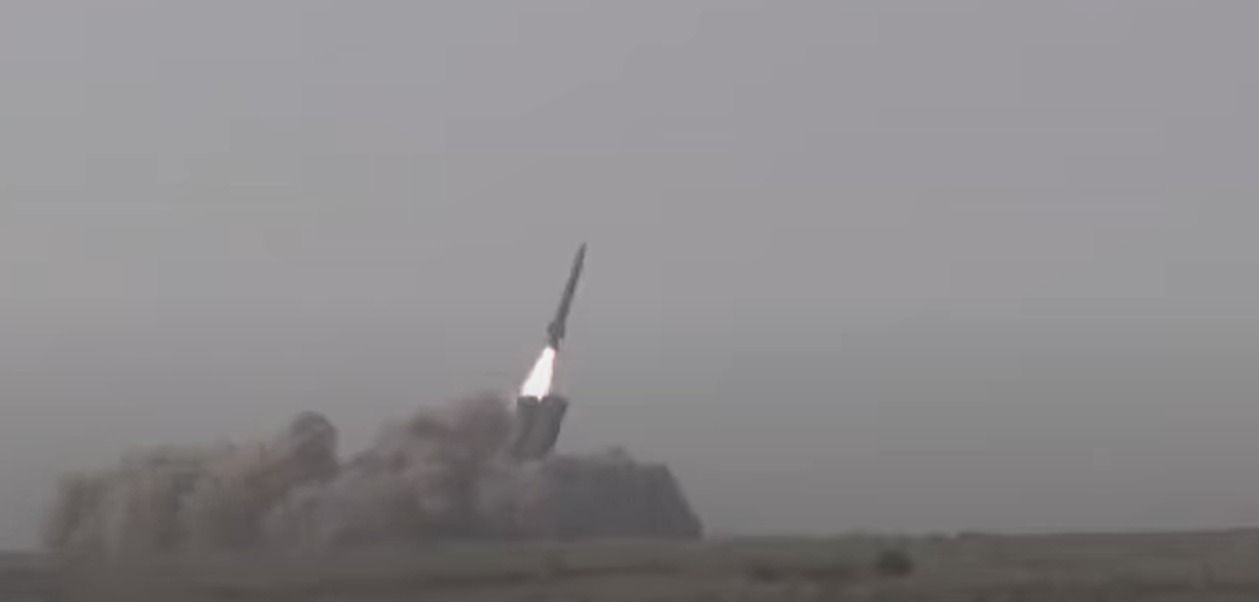Pakistan recently tested its indigenous long-range precision strike weapon, the Fatah-II. With an impressive range of approximately 249 miles (400 km), the missile system is positioned by Islamabad as a potential challenge to India’s S-400 missile defense systems.
The Inter-Services Public Relations (ISPR) divulged vital details about the Fatah-II. It showcased advanced features, including state-of-the-art avionics, a sophisticated navigation system, and a distinctive flight trajectory.
Video footage released by ISPR provides a closer look at the Fatah-II, revealing its identity as a two-round guided multiple-launch rocket system mounted on the Chinese Taian TAS5450 eight-wheel drive chassis.
Setting itself apart within the Fatah rocket series, the Fatah-II incorporates cutting-edge flight control technology and a refined pathfinding mechanism.
This includes the integration of satellite and inertial navigation systems, which ensure an exceptional level of accuracy with a circular probable error (CEP) of less than 10 meters.
This precision targeting capability underscores the Fatah-II’s significance in advanced missile technology.
Speaking to EurAsian Times, Umair Aslam, CEO of Global Defense Insight (an Islamabad-based security forum) & security analyst, said, “With the successful test of the Fatah-II, the Pakistani military has enhanced its capability to engage strategic targets, such as bridges and air defense units, located within a range of 400 kilometers. Utilizing cutting-edge navigation and avionics technologies empowers the Fatah-II to achieve the best accuracy.”
The weapon system seamlessly complements existing models such as the Fatah-I, the Chinese A-100, the Yarmouk series, and the Nasr tactical ballistic missiles.
Notably, the Fatah-II’s ability to accurately target locations over a distance of 400 kilometers marks a substantial advancement in the field of long-range artillery, surpassing its predecessor, the Fatah-I, which boasts a range of 140 kilometers.
Military analysts have labeled the Fatah-II a “flat trajectory missile,” a design attribute that poses a radar detection challenge.
Reports suggest that the missile’s design deliberately incorporates this characteristic, which provides a strategic advantage by making it challenging to detect and enabling precise targeting.
Threat To India’s S-400 Air Defense System?
After successfully testing this advanced missile system, international experts and the Pakistani media have labeled it as a viable solution against India’s state-of-the-art S-400 missile system.
Many experts believe that Fatah-II could play a crucial role in what Pakistan considers essential for deterring India. As stated, ‘Fateh II’ follows a flat trajectory, presenting a more significant challenge in terms of detection on radar.
Umair Aslam said, “Upon integration into the operational framework of the Pakistan Army, the Fatah-II presents a formidable challenge to the Indian armed forces.”
Furthermore, he pointed out, “The Fatah-II demonstrates its potential to counter advanced air defense systems, exemplified by its ability to effectively engage the S-400 through saturation attacks, employing a combination of Fatah-II projectiles, cruise missiles, loitering munitions, and Fatah-I Guided Multiple Launch Rocket System (GMLRS). It’s a great development in the Pakistani military arsenal, and credit goes to Pakistani engineers and scientists for developing indigenous Fatah-II.”
Frank O’Donnell, a nonresident fellow associated with the South Asia Program at the Stimson Center think tank, contends that the creation of Fatah-2 indicates Pakistan’s astute observations drawn from recent conflicts such as the Azerbaijan-Armenia and Russia-Ukraine wars.

According to him, this involves recognizing the benefits of assigning precision ground bombardment tasks to cost-effective artillery and combat drone systems for adversaries, thus reserving manned fighter aircraft for more advanced strike missions and intercepting their counterparts.
On the other hand, in conversation with EurAsian Times, Defense analyst Patricia Marins expressed skepticism, pointing out the lack of information regarding the missile’s unique trajectory.
Marins emphasized the need for more details on the missile’s evasive maneuver capabilities and questioned the effectiveness of its navigation system.
She highlighted the S-400 system’s tested performance in Ukraine and suggested the possibility of crucial upgrades. The question arose of whether these upgrades would be extended to the Indian S-400 system.
However, she raised concerns about India’s locally developed air defense systems like (SAMAR) and suggested potential adjustments might be necessary to intercept massive rockets like the Fateh-2.
Drawing from lessons learned during the early months of anti-air systems deployed in Ukraine, Marins underscored the vulnerability of untested systems to various missile threats.
Highlighting the challenges posed by the Fateh-II, Marins said that the high range and considerable mobility make it elusive for anti-missile systems to locate launchers effectively.
The Ukrainian conflict served as a stark reminder that any missile can pose a threat to anti-missile systems, particularly those lacking real-war testing.
- Contact the author at ashishmichel@gmail.com
- Follow EurAsian Times on Google News